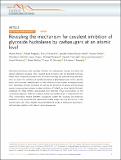Files in this item
Revealing the mechanism for covalent inhibition of glycoside hydrolases by carbasugars at an atomic level
Item metadata
| dc.contributor.author | Ren, Weiwu | |
| dc.contributor.author | Pengelly, Robert Joseph | |
| dc.contributor.author | Farren-Dai, Marco | |
| dc.contributor.author | Abadi, Saeideh Shamsi Kazem | |
| dc.contributor.author | Oehler, Verena | |
| dc.contributor.author | Akintola, Oluwafemi | |
| dc.contributor.author | Draper, Jason | |
| dc.contributor.author | Meanwell, Michael | |
| dc.contributor.author | Chakladar, Saswati | |
| dc.contributor.author | Świderek, Katazyna | |
| dc.contributor.author | Moliner, Vincent | |
| dc.contributor.author | Britton, Robert | |
| dc.contributor.author | Gloster, Tracey | |
| dc.contributor.author | Bennet, Andrew | |
| dc.date.accessioned | 2018-08-14T14:30:05Z | |
| dc.date.available | 2018-08-14T14:30:05Z | |
| dc.date.issued | 2018-08-13 | |
| dc.identifier | 255285653 | |
| dc.identifier | 2c1ce514-4978-400c-9a2c-b55d5882b6e5 | |
| dc.identifier | 85051629558 | |
| dc.identifier | 000441382000021 | |
| dc.identifier.citation | Ren , W , Pengelly , R J , Farren-Dai , M , Abadi , S S K , Oehler , V , Akintola , O , Draper , J , Meanwell , M , Chakladar , S , Świderek , K , Moliner , V , Britton , R , Gloster , T & Bennet , A 2018 , ' Revealing the mechanism for covalent inhibition of glycoside hydrolases by carbasugars at an atomic level ' , Nature Communications , vol. 9 , 3243 . https://doi.org/10.1038/s41467-018-05702-7 | en |
| dc.identifier.issn | 2041-1723 | |
| dc.identifier.uri | https://hdl.handle.net/10023/15818 | |
| dc.description | Financial support from the Natural Sciences and Engineering Research Council (NSERC) of Canada (AJB Discovery Grants: 121348–2012 & 2017–04910) was received. T.M.G. and V.O. are funded by a Wellcome Trust Career Development Fellowship, R.P. by Wellcome Trust ISSF, M.M. by a NSERC CGSD, M.F.-D. by a NSERC CGS-MSFSS and a GlycoNet Research Exchange Program, and R.B. by NSERC Discovery Grant and by a MSFHR Career Investigator Award. V.M. and K.Ś. thank the Spanish Ministerio de Economía y Competitividad and FEDER funds (project CTQ2015-66223-C2) and a Juan de la Cierva – Incorporación (ref. IJCI-2016-27503) contract, respectively, and Universitat Jaume I (project UJI·B2017-31). | en |
| dc.description.abstract | Mechanism-based glycoside hydrolase inhibitors are carbohydrate analogs that mimic the natural substrate’s structure. Their covalent bond formation with the glycoside hydrolase makes these compounds excellent tools for chemical biology and potential drug candidates. Here we report the synthesis of cyclohexene-based α-galactopyranoside mimics and the kinetic and structural characterization of their inhibitory activity toward an α-galactosidase from Thermotoga maritima (TmGalA). By solving the structures of several enzyme-bound species during mechanism-based covalent inhibition of TmGalA, we show that the Michaelis complexes for intact inhibitor and product have half-chair (2H3) conformations for the cyclohexene fragment, while the covalently linked intermediate adopts a flattened half-chair (2H3) conformation. Hybrid QM/MM calculations confirm the structural and electronic properties of the enzyme-bound species and provide insight into key interactions in the enzyme-active site. These insights should stimulate the design of mechanism-based glycoside hydrolase inhibitors with tailored chemical properties. | |
| dc.format.extent | 12 | |
| dc.format.extent | 1498518 | |
| dc.language.iso | eng | |
| dc.relation.ispartof | Nature Communications | en |
| dc.subject | QH301 Biology | en |
| dc.subject | QD Chemistry | en |
| dc.subject | DAS | en |
| dc.subject | BDC | en |
| dc.subject | R2C | en |
| dc.subject.lcc | QH301 | en |
| dc.subject.lcc | QD | en |
| dc.title | Revealing the mechanism for covalent inhibition of glycoside hydrolases by carbasugars at an atomic level | en |
| dc.type | Journal article | en |
| dc.contributor.sponsor | The Wellcome Trust | en |
| dc.contributor.institution | University of St Andrews. School of Biology | en |
| dc.contributor.institution | University of St Andrews. Biomedical Sciences Research Complex | en |
| dc.identifier.doi | 10.1038/s41467-018-05702-7 | |
| dc.description.status | Peer reviewed | en |
| dc.identifier.url | https://doi.org/10.1038/s41467-018-06264-4 | en |
| dc.identifier.grantnumber | en |
This item appears in the following Collection(s)
Items in the St Andrews Research Repository are protected by copyright, with all rights reserved, unless otherwise indicated.

